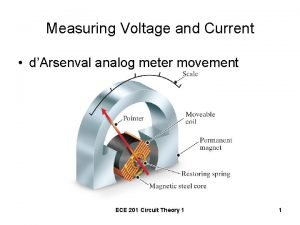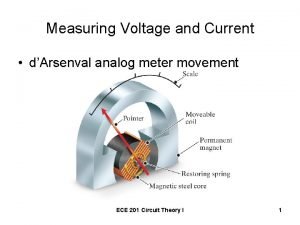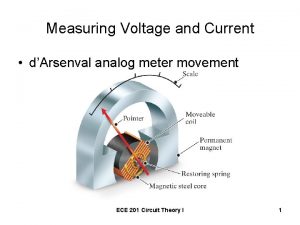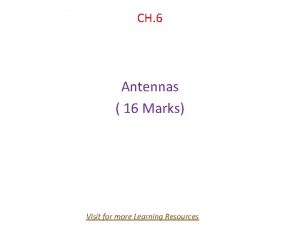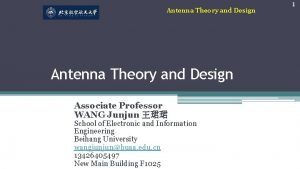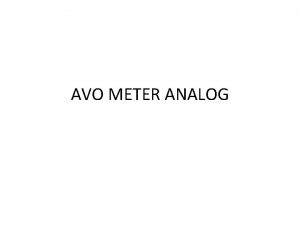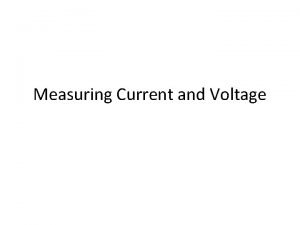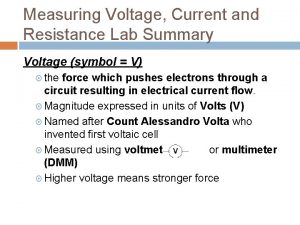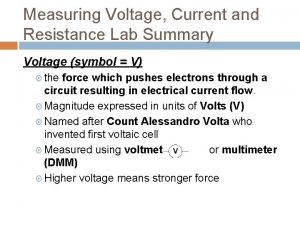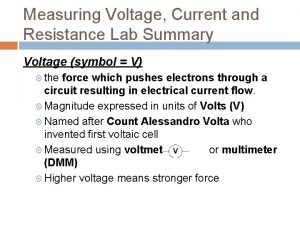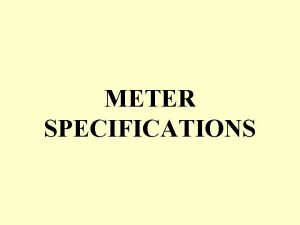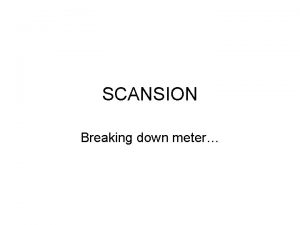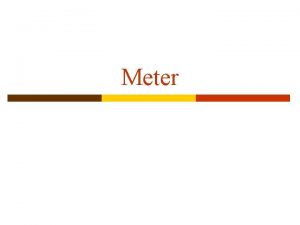Measuring Voltage and Current dArsenval analog meter movement












- Slides: 12

Measuring Voltage and Current • d’Arsenval analog meter movement ECE 201 Circuit Theory I 1

Analog Ammeter • Use a d’Arsenval meter movement with a parallel resistor (shunt). • The parallel resistor diverts some of the current away from the meter movement. ECE 201 Circuit Theory I 2

Analog Voltmeter • Use a d’Arsenval meter movement in series with a resistor (multiplier). • The resistor limits the voltage drop across the meter movement. ECE 201 Circuit Theory I 3

Sources of Error • Any instrument (meter) used to make measurements extracts energy from the circuit. (Known as “loading” the circuit). • The amount of error due to loading depends on the effective resistance of the instrument compared with the resistance in the circuit. ECE 201 Circuit Theory I 4

Rule of the “one-tenth” • The effective resistance of the ammeter should be no more than 1/10 th of the value of the smallest resistance in the circuit. – The current being measured should be the same with or without the ammeter. ECE 201 Circuit Theory I 5

For a Voltmeter • Since voltage is a parallel measurement, the “loading” effect is minimized when the voltmeter resistance is much higher than the circuit resistance across which the measurement is being made. ECE 201 Circuit Theory I 6

Problem # 3. 32 • An ammeter with a resistance of 0. 5Ω is used to measure the current io in the circuit. • What is the % error in the measured value? ECE 201 Circuit Theory I 7

io ECE 201 Circuit Theory I 8

Problem # 3. 33 • A d’Arsenval voltmeter is shown. Determine the value of Rv for a full-scale reading of 5 Volts. ECE 201 Circuit Theory I 9

Choosing the Multiplier Resistor • When 5 V is applied, the meter will be at full-scale deflection. • The meter resistance is 50Ω. • Total resistance needs to be 5 kΩ. • The series resistor Rv (multiplier) needs to be 4950Ω. ECE 201 Circuit Theory I 10

Problem # 3. 34 • The d’Arsenval voltmeter described in Problem # 3. 33 is used to measure the voltage across the 24Ω resistor. ECE 201 Circuit Theory I 11

What will the voltmeter read? What is the % error in the reading? ECE 201 Circuit Theory I 12
 Analog meter movement
Analog meter movement Analog meter movement
Analog meter movement Analog meter movement
Analog meter movement Line current and phase current
Line current and phase current What are the objectives of earthing
What are the objectives of earthing Rms and peak voltage relationship
Rms and peak voltage relationship Low voltage vs medium voltage
Low voltage vs medium voltage Single phase voltage controller
Single phase voltage controller Mig voltage chart
Mig voltage chart Parallel vs series
Parallel vs series Current and voltage distribution in antenna
Current and voltage distribution in antenna Current and voltage distribution in antenna
Current and voltage distribution in antenna Energy voltage current
Energy voltage current
